
August 2013 - Present
Yet Another RPG is a Role-Playing Game, or RPG, that parodies and satirizes common tropes and clichés of popular video games of its genre. Styled like the original classics of the genre, Final Fantasy and Dragon Quest, players join the protagonist, a smug angel named Arial, through the episodic story as they attempt to figure out why he was exiled from the Over Overworld. A new episode (stylized as a "Demo") is released every year that continues the story, kind of like a TV show.
If you are interested in Yet Another RPG, you can visit the website here!
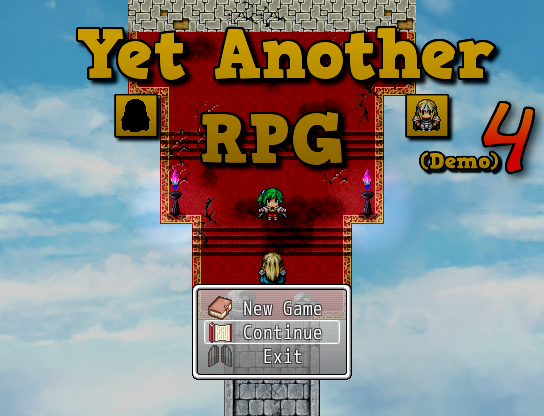 The title screen of Yet Another RPG - Demo 4.
The title screen of Yet Another RPG - Demo 4.I started developing the game back in 2013 and since then, it's become my most important project. To build the game, I utilize a program called RPG Maker VX Ace, which, as you might have guessed, is a game engine specifically for projects like this.
As the game's sole developer, I handle nearly every aspect of the project's existence, be it the battle systems, narrative outlining, character designs, pixel sprites, coding, implementation, user testing... and, well, everything else that can possibly fit in a game like this.
Let's talk about a few of them.
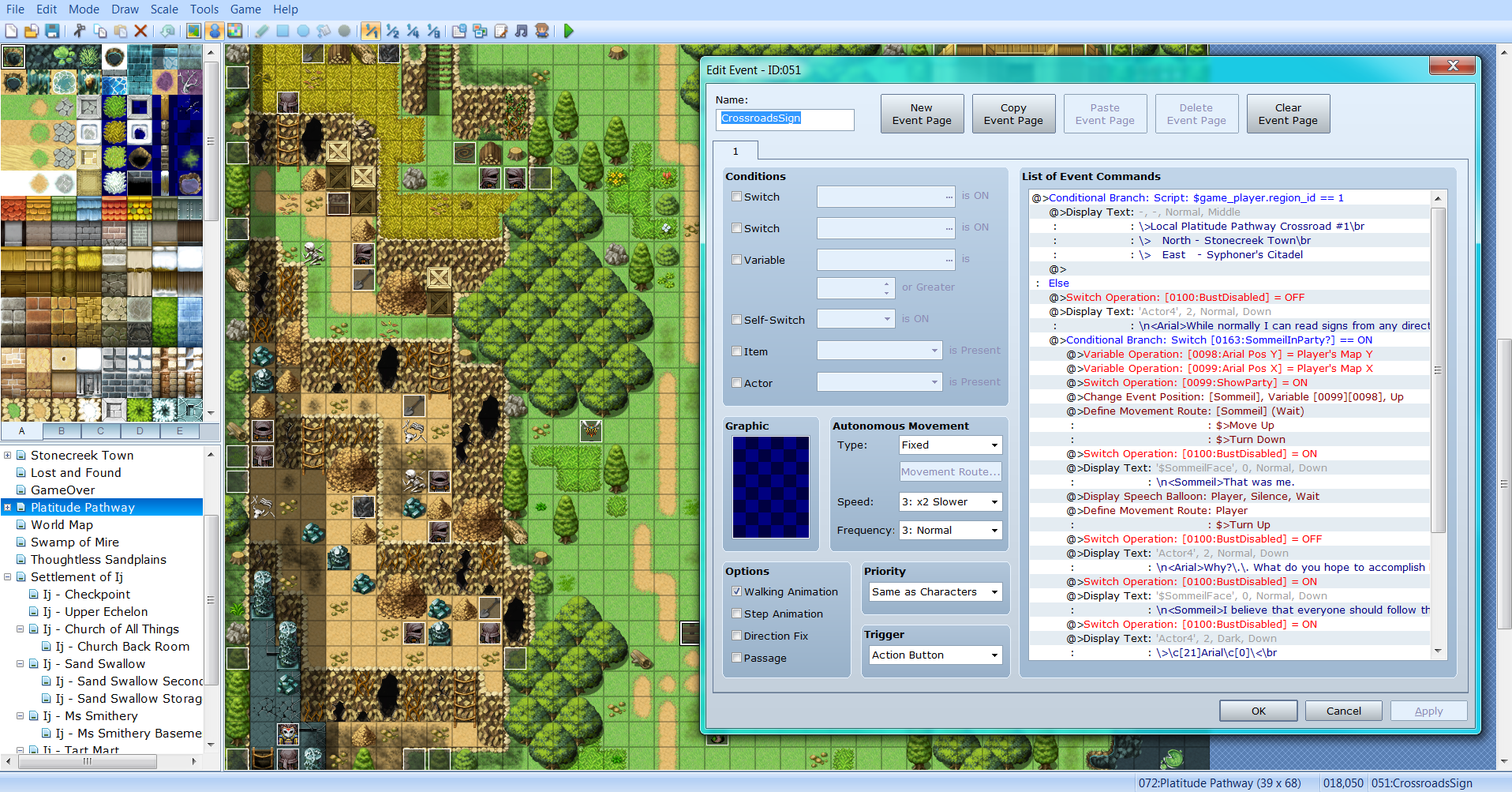 RPG Maker VX Ace's editor showcasing one region in the world of Yet Another RPG alongside the logic implementation of an object within said region.
RPG Maker VX Ace's editor showcasing one region in the world of Yet Another RPG alongside the logic implementation of an object within said region.Game Design
I love RPGs. I grew up with them. They're partially why I've studied to become a game design generalist. While I've dabbled with several other minor projects before Yet Another RPG, this project was what fueled my passion for the industry. For this project, I wanted to draw from my extensive background growing up with these games to make something just like it. A standard, if you will... but with a twist.
The game makes fun of its own genre. I've noticed a lot of the same types of character designs, narrative plothooks, environments, etc., when playing these sorts of games, and I wanted to parody those tropes using my favored type of humor: lighthearted sarcasm.
That's the fundamental principle behind the entire game and it's what I consistently refer to in its game design when implementing everything from the character dialogue, to the sprites, to the programming scripts, and more. For example, one of Arial's companions is a swordswoman named Lexie. She often dies a lot in the story for completely absurd reasons. But! She thinks herself the protagonist of the game, and so she has the power to press the "Continue" button on the Game Over screen to try again! It's a funny little quip that's become a running gag throughout the story.
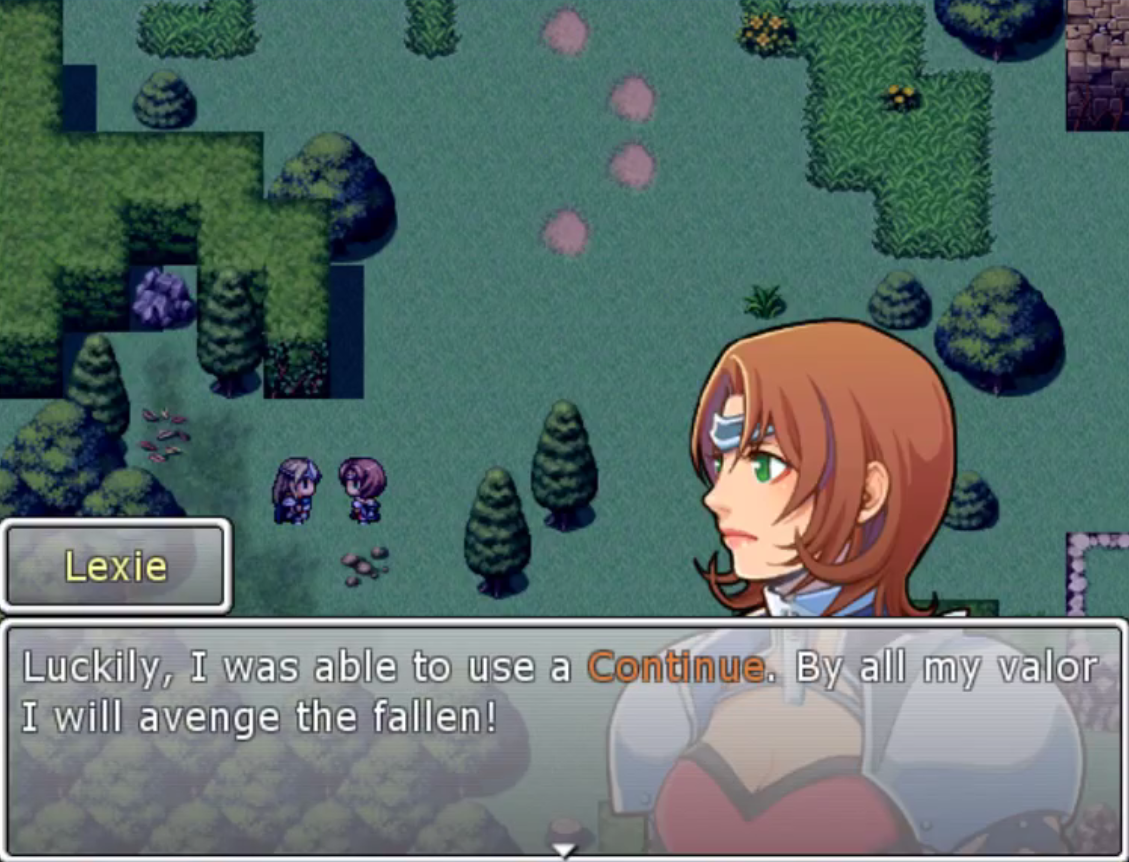 Lexie says she can use a Continue to ressurect herself.
Lexie says she can use a Continue to ressurect herself.I do much of my work within the actual editor of RPG Maker VX Ace. I paint regions of the world appropriate for the story using thematic tilesets. Since the game is on a grid system, each tile is 32x32 pixels, mimicking that of earlier RPG games. I bring in different tilesets either from my own creation, or the software's default tilesets, to create the world. If the editor doesn't have a default for—say a desert tile—I either create it myself or find free, community-generated resources from forums I'm active in.
Each region, or map, has a specific purpose in function. While aesthetics and environmental storytelling is a factor I consider in what I want to convey to the player, what the map offers to them in functionaltiy is equally important. Let's go with a map made of desert-esque tiles. In a fantasy RPG, what's roaming around in a dangerous desert? For this map, I want there to be some monstrous, roaming skeletons, undead remnants of careless travelers who died of heat exhaustion.
A monster for our player to fight and gain experience! That's a good idea, even if it may be complex to implement.
I first start with designing the enemy data itself. What are its stats? Is it balanced for a player who may be rushing through the game (and therefore be at a lower level than the average player), and/or will it be too easy for a player who's been going through the game with a slower, more thorough pace (and therefore be at a higher level than the average player)? In tandem with that, I design a unique ability in battle for the creature to use. The unique ability is directly determined by what role the creature serves. Is it meant to be a tough battle for the player? Or is it only meant to be a hindrance at best? Perhaps an evil curse that causes the player's characters to skip a turn in battle may best suit the former, rather than the latter.
Some of these abilities require a new animation, so that the player sees a visual effect and not something repeated from earlier in the game. Creating an animation means taking several 2D sprites of a visual effect and combining them on a frame-by-frame basis. Then, I associate that animation with that particular unique ability. I repeat this for every ability that a monster or a player's character might have.
Then, I find a suitable appearance for our skeleton. This is a usually a drawn sprite that matches the stats and unique ability we gave our monster along with the environment that the player will encounter it in.
With that in place, it's finally time to insert our skeleton to our desert map. I would create an event, give it the appearance that we selected, and plop it down in our region! I also have to implement the logic within the event so that it functions and interacts with the player. I can have our skeleton walk slowly towards the player if it spots them, or have it wander aimlessly. If the player collides with the skeleton, I have the event initiate a battle!
From our small exercise, it's easy to see that everything is interconnected. My job as a game designer is extremely holistic. I have to make sure everything follows the three "F"s, it's functional, it's fun, and it follows the underlying fundamental principle: possessing lighthearted sarcasm that parodies the genre. All this while maintaining its own unique identity as a standalone game? It's a tough challenge, but one that's earned me a whole diverse skillset that I'm proud of.
Writing
The storytelling of Yet Another RPG is one of the highlights of the project. As with any RPG, the story takes center stage. Unlike most RPGs though, I must take critical care to make the narrative of my game both unique and a parody of others in its genre. I can't make fun of a trope if I don't use it, right?
One of the main driving factors of the story is the dialogue and overarching plot. Each Demo is thematic to a certain subgenre of tropes I want to parody. For example, Demo 4 parodies the Massively Multiplayer Online RPG (MMORPG) genre, where the characters make references to common things that happen in those kinds of games. And, as always, Arial questions why that happens with his snarky attitude. With references to the entire history of RPGs galore, it's up to Arial to smartly, yet smugly, disassemble the genre in a way that critically analyzes how beautiful, yet silly our favorite games can be.
Plus, narrative storytelling, outlining the plot of each Demo, and planning how character development occurs is one of my favorite parts of developing Yet Another RPG. It's not all sarcastic quips; there's a lot of genuine sincerity that I've dispersed in there as well. It'd be boring quickly if all there was to the story was the same old witty reactions every time, right?
Programming
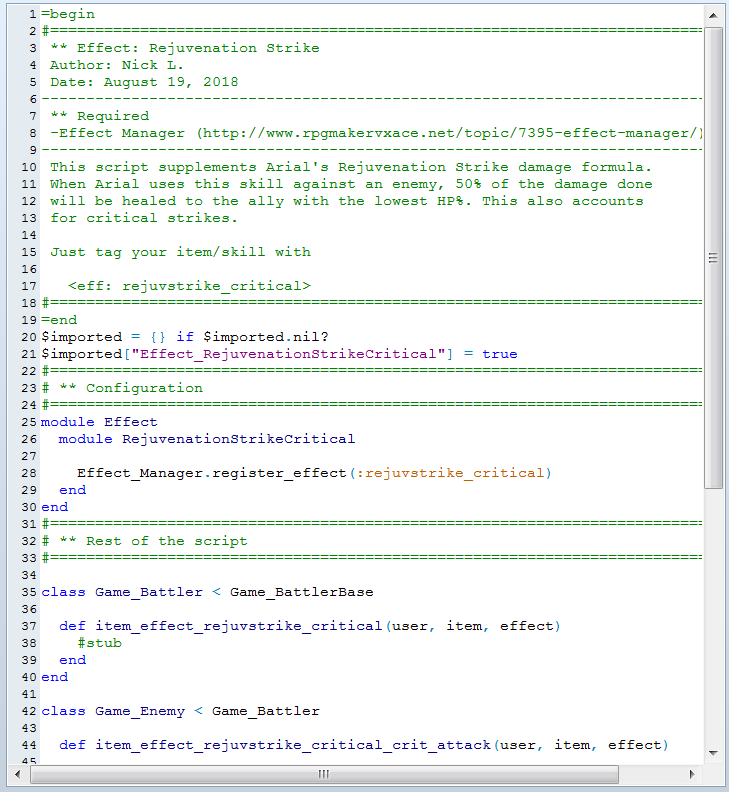 The script editor for RPG Maker VX Ace, featuring one of my own scripts to supplement a battle skill.
The script editor for RPG Maker VX Ace, featuring one of my own scripts to supplement a battle skill.RPG Maker VX Ace runs on a Ruby programming framework called RGSS3. The engine isn't perfect; in fact, it's quite barebones. To really stretch the engine to its limits, one would need to learn how to script in Ruby.
So I did.
Luckily, everything about the base engine in RPG Maker VX Ace is modifiable via its scripts. And luckily, there are a lot of talented programmers in the RPG Maker community that provide their scripts for complex features, insanely good quality of life improvements, and other stability adjustments. It is from these that I learned how to program in Ruby and alter these scripts to suit Yet Another RPG. It is also from them that I've learned how to code my own scripts, like the one seen in the image above.
There are about 100 custom scripts so far in Yet Another RPG, all either coded or altered by me in some fashion. These range from completely changing the default battle system in RPG Maker, to creating an entirely new feature such as the Quest Log, to preventing game slowdowns in maps containing highly condensed events, and much more. The scripts are the backbone of the project. Having built coding knowledge of Ruby throughout these past few years has taught me to properly program and discern what sort of features are feasible and what might be a tall order / incompatible with other scripts.
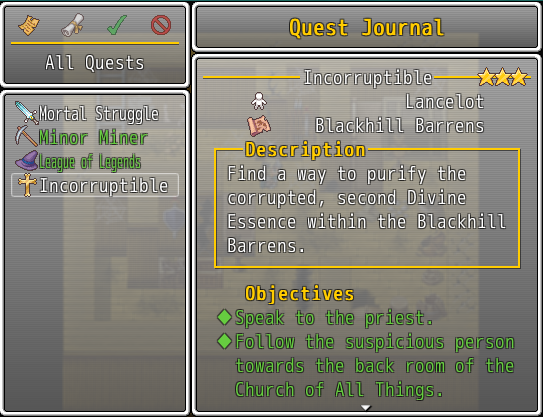 The Quest Log feature, a completely original function added to the RPG Maker engine.
The Quest Log feature, a completely original function added to the RPG Maker engine.Spriting
The art style of Yet Another RPG is reminiscent of classic Japenese RPGs. In RPG Maker, several default tiles, characters, enemies, and other artwork come with the software. While it's a great start-up to eliminate the need to create your own assets, it's only meant to be a generic set of resources. If you want anything specific, you'll have to make it yourself.
This project features tons of custom-made art assets, whether made by myself or taken from talented artists who graciously create free resources to host on community-ran forums.
There are lots of custom sprites: including tilesets, object sprite sheets, character portraits, enemy sprites, UI menus, ability / item icons, cutscene artwork, and more.
When spriting my own artwork for the game, I use a free image-editing program called GIMP as my preferred software of choice. When spriting, I make sure that any additional assets I bring into the game match the art style (or have a good reason if it isn't). Because of my process of creating new a enemy monster, a new unique ability, etc., I often times have to draw a custom sprite for them as well.
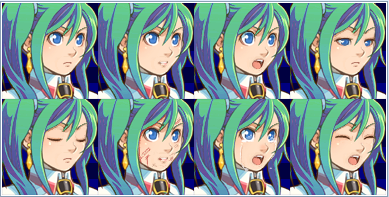 Aurora's different emotions that she can "display" in dialogue.
Aurora's different emotions that she can "display" in dialogue.Let's take Aurora, one of the companions Arial can come across in the game. Normally, characters in this world only have one basic face sprite, and thus, one emotion they can display in dialogue. Aurora possesses a mysterious power to display a wide variety of emotions due to the fact that she is mute. While it certainly adds a unique... "voice," to her personality, it called for a lot of custom face sprites for her.
Each "face set" file contains 8 sprites, one for each face (which can be for emotions, or different characters can share a single face set file). To put it in perspective, Arial has only one face sprite ever—taking only one spot on a face set file. Aurora has eleven face set files... 88 custom face sprites. Spriting her faces took a month alone to do. I had to account for every possible emotion she would be able to express throughout the rest of the game.
Data Organization & Analysis
As mentioned multiple times before, I am the project's single and sole developer. Which means all of the organization falls onto me to handle. Planning documents, idea sheets, timelines, etc., all must be structured in an accessible way so that it's easy to find for my own purposes.
It's not just keeping things organized though, research is a heavily vital aspect to Yet Another RPG. For a game that satirizes others in its genre, researching common tropes, plot threads, narrative structures, etc., plays a large part to its success. A protagonist that mocks the something that isn't touched on in the genre will only leave players bewildered and blindsided. I take proper care in thoroughly researching what makes these games fascinating and simultaneously cliché so that I may replicate it in my own project with its trademark humor. This can result in playing many different types of RPGs for first-hand experience, gauging players' experiences online via forums, and critically analyzing online websites, blogs, articles, etc., on RPGs. A game review can oftentimes be valuable information, since reviewers tend to ask if a game is generic and why, if it is. Every detail is important to developing the plot of the project.
Another of my duties is user testing the game before release every year. Playtesting is a thorough responsibility that requires simulating a new player's playthrough of the game whilst also searching for bugs and glitches. While I do a lot of the playtesting myself, I also incorporate volunteers to help months before release of a Demo. I compile a form that details what tasks the playtesters have and what they should look out for during their playthroughs. Their feedback is immensely insightful, which have lead to some edits such as game-changing balance modifications so that some tough boss enemies are easier for players with minimal experience in the genre (after all, I want all players to find enjoyment within the game). Player feedback is very helpful, because despite being a multidisciplinary game design generalist, I'm not perfect. It's inevitable that I overlook one aspect and it's my playtesters that bring it into sight!
It's also worthy to mention that this includes management over Yet Another RPG's social media presence and website. Development of the game's website can be found on its respective portfolio page. Social media details a maintained profile of the project on Twitter and Facebook, posting updates on game development and following trends of various "memes" and jokes circulating throughout the Internet, utilizing them to full effect with a fresh coat of Yet Another RPG paint.
 The profile of Yet Another RPG's Twitter account.
The profile of Yet Another RPG's Twitter account.Graphic Design
Graphic design is vital to the presentation of the game. The first thing that folk typically see is the presentation of the game on social media or its site, and thus, they will judge that. A sleek and clean website, social media banners and profile pictures pave the way for interested parties. If it doesn't look like attention was put into it, then I have found that many folk are turned off, even if the game looks great.
Like with spriting, I utilize the free image-editing program GIMP to create the graphics I use for promotional materials and web design. It's important to keep these true to the theme of the project and to promote positivity towards its very nature. One principle I adhere to is that many of my social media posts make use of images, questions, and teasers for upcoming episodes to increase engagement. After all, engagement is the central variable in many social media platform's algorithms.
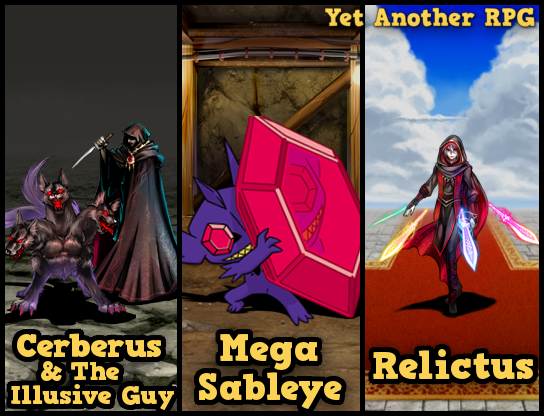 The image of a post on Yet Another RPG's social media accounts of the three bosses from Demos 1 - 4. The post asks users who they thought was their favorite.
The image of a post on Yet Another RPG's social media accounts of the three bosses from Demos 1 - 4. The post asks users who they thought was their favorite.Cultural Anthropology
I have a great interest in anthropological studies. Culture, linguistics, and archaeology are fascinating fields of study that can help understand portions of our societies' multifaceted values and ideals.
Frequently in RPGs, players tend to travel throughout a fictional world, learning a lot surrounding the lore of its histories and peoples. I always love reading about a fictional kingdom's history, politics, values, etc., when trying to understand how we as a player interact with it.
Cultural anthropology has an interesting segment within my development of Yet Another RPG. It provides a set of lenses from which we can view different regions of the fictional world I've built. In Demo 5, players visit the Settlement of Ij, made up of residents who are devout believers of a particular religion. Arial, as an angel of this said religion, has a first-hand account of many things that the townspeople revere and worship. That gives way to intriguing interactions and exchanges.
In many RPGs, one of the common complaints I've discovered is that the world feels monotonous and repetitive. Environments may be different, but hunters in a snowy valley act the same as peasants in a kingdom's backwater village. While I may mock that trope in my game, I feel it a disservice to replicate it 1-for-1. Variety and representation of minority groups is personally important to me, so I vow to positively portray them in my game.
For example, the Settlement of Ij in Demo 5 is comprised of a majority of black-colored folk and many are in thriving positions of power. Racial issues are nonexistent in Yet Another RPG, as I see those conflicts as baseless, cheap hooks for a poor narrative. Great care is taken to give minority characters the light of day with as much personality, role, and design as other characters.
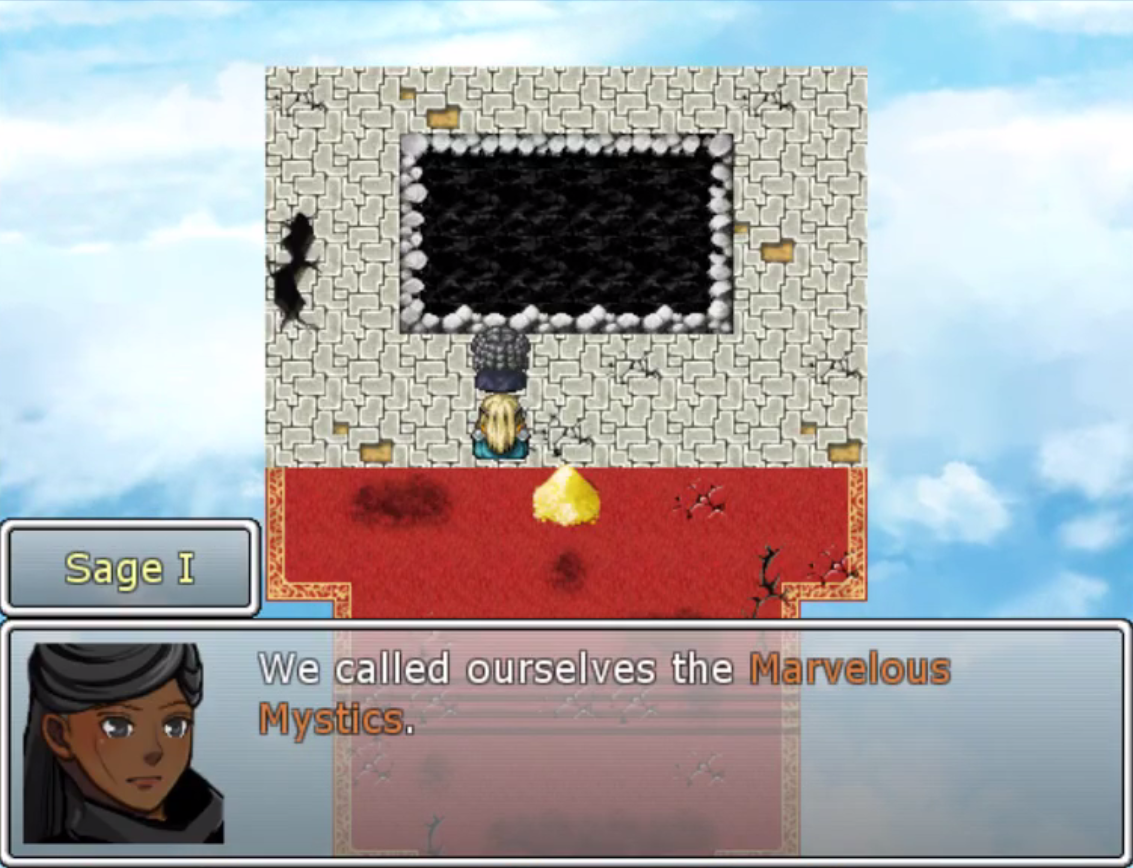 The leader of one of the most successful organizations in the world of Yet Another RPG is a black woman.
The leader of one of the most successful organizations in the world of Yet Another RPG is a black woman.